Living in a small space doesn’t mean you have to feel cramped or stuck. Tons of people wrestle with tiny rooms, but most have no clue about the designer tricks that can totally change the vibe.
Remember to repin your favorite images!
With a handful of clever design moves, you can make even the smallest room look way more open—no need to knock down any walls.

Small spaces bring their own set of challenges, sure, but they also open the door to creative solutions. Stuff like where you put mirrors or which furniture you pick can totally shift how a room feels.
These changes aren’t just about looks—they actually play with how our brains process space. It’s kind of wild.
You don’t need a huge budget or a big renovation to make this work. Most of these tricks are easy enough to pull off in a weekend.
Whether you’ve got a tiny bedroom, a cramped living room, or a kitchen that feels like a closet, these fifteen ideas help you maximize your space both visually and practically.
Maximizing Light for an Open and Airy Feel
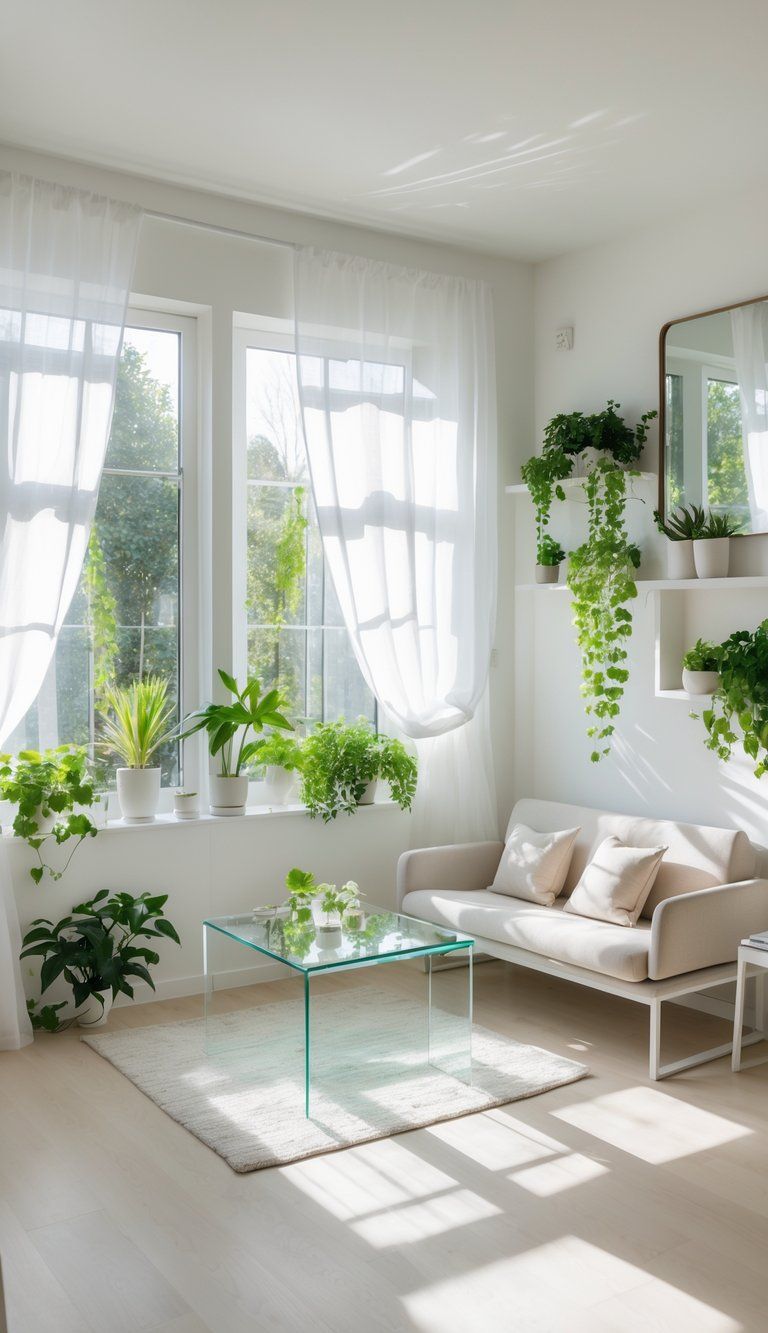
Light changes everything in a small room. If you get the lighting right, even the tiniest spot can feel open and inviting.
Welcoming Natural Light
Natural light is your best friend when you want a small room to look bigger. Ditch heavy curtains and go for sheer window coverings that let the sun in but still offer some privacy.
Move your furniture away from the windows so you don’t block that precious sunlight. Light window frames help, too—they bounce more light around than dark ones.
Swap in glass-paneled doors for rooms without windows. You’ll let borrowed light flow between spaces, which really helps.
If you don’t care about privacy, just leave the windows bare during the day. The outdoors kind of merges with your space, and those walls seem to fade away.
Quick fix: Trim back any trees or bushes outside that might be stealing your sunlight.
Strategic Use of Mirrors
Mirrors are like magic for small rooms. Put a big mirror across from a window and watch natural light bounce all over the place.
Lean a full-length mirror against the wall to make the ceiling look higher. For the best effect, angle mirrors so they reflect the prettiest view or the brightest light.
Mirrored furniture—like a coffee table or a console—does double duty. It’s useful and it bounces light around. Even small mirrored accents, like picture frames or trays, help out.
Here’s a fun one: Mix up a gallery wall with mirrors in all sorts of shapes and sizes. It looks cool and makes the room feel bigger.
Effective Artificial Lighting
Don’t let a single overhead light do all the heavy lifting. Layer your lighting—use ambient, task, and accent lights to add depth and chase away those dark corners.
Wall sconces and uplights pull your eyes up, which tricks you into thinking the room is taller. Scatter table and floor lamps around to create little pools of cozy light.
Pick light fixtures made from glass or acrylic so you don’t block sightlines. They light things up without feeling heavy.
Add under-cabinet lighting in the kitchen or go with recessed lights if your ceiling is low. You get great light without eating up space.
LED strip lights tucked into shelves or behind furniture give off a soft glow. They make walls seem farther away, which is exactly what you want.
Choosing Color Schemes to Enhance Space
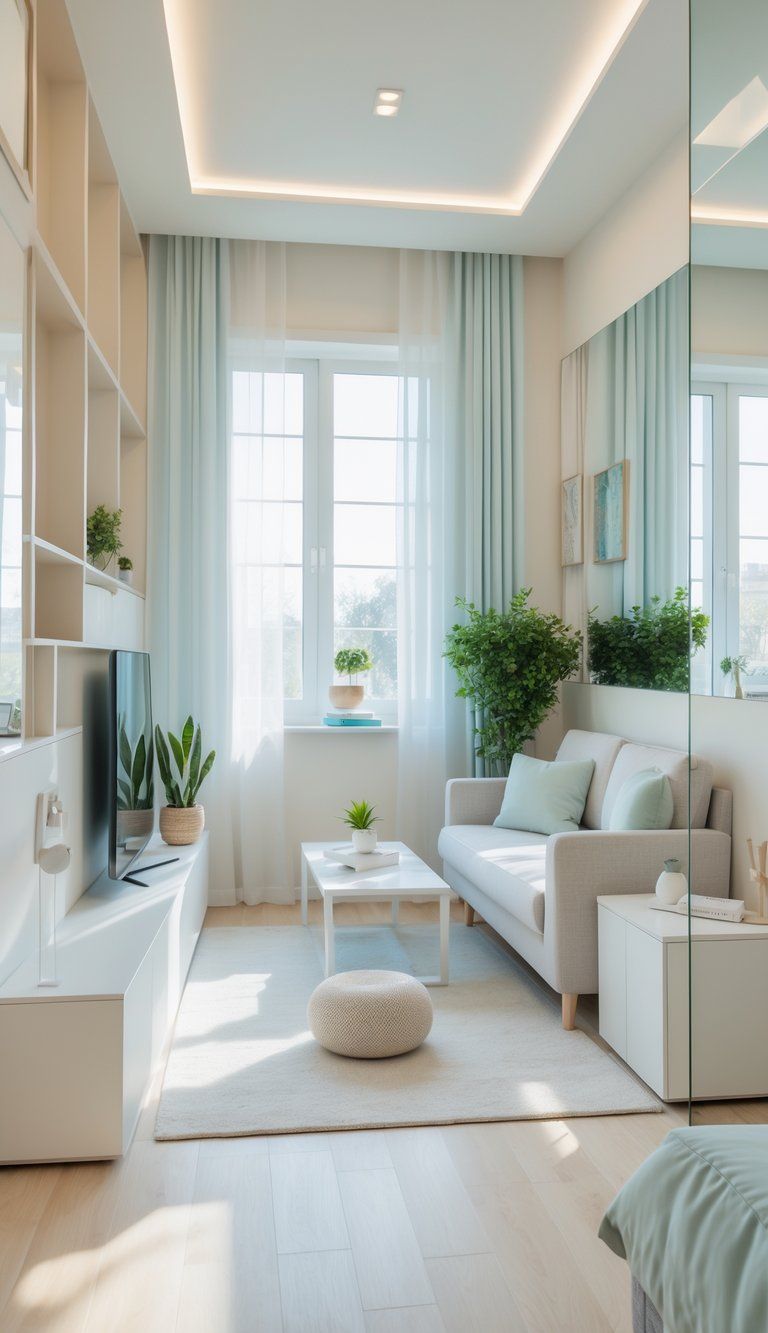
Color might be the biggest cheat code for making a small room feel bigger. The right color choices can push back the walls, lift the ceiling, and open things up—no construction required.
Light and Neutral Hues
Light colors reflect more light, so they naturally make small rooms feel airy. Think white, beige, pale gray, or even a soft yellow. These shades keep things bright and open.
When you paint, try a satin or eggshell finish. The slight sheen helps bounce light around more than flat paint does.
Keep your color palette light for furniture and decor, too. Sofas, chairs, and curtains that match the walls don’t break up the space.
A neat little trick: Paint your baseboards and trim just a bit lighter than the walls. It’s subtle, but it makes the walls seem to fall away.
Effective Uses of Accent Walls
An accent wall can actually help a small space, if you do it right. Pick the wall that grabs your attention when you walk in.
Put a dark color on the shortest wall in a rectangular room. It’ll make the room look deeper, almost like it stretches further than it does.
Try deep navy or charcoal for drama, or go with a bold pattern that fits your vibe. Textured finishes like shiplap in a light shade also work.
Stick to one accent wall, though. Too many bold walls crowd the space and make it feel boxed in.
Ceiling Color Strategies
Don’t forget the ceiling—it’s basically your room’s fifth wall. White is classic, but you can get creative to make the ceiling feel higher.
Paint the ceiling one shade lighter than your walls for a gentle lift. It draws your eyes up without being obvious.
If your room gets plenty of sunlight, try a pale blue ceiling. It mimics the sky and makes things feel open above you.
For really low ceilings, use high-gloss paint. It reflects light and adds depth, especially in a dining room where the fixture can bounce off it.
Cohesive Color Palettes
Stick with a cohesive color scheme across your space to help rooms flow together. Use 2-3 main colors and one accent color—don’t overdo it.
Follow the 60-30-10 rule:
- 60% dominant color (think walls and big furniture)
- 30% secondary color (curtains, bedding, accent chairs)
- 10% accent color (art, pillows, little accessories)
Carry your color scheme into nearby spaces so everything connects visually. It’s a small detail, but it really makes the whole place feel bigger.
Monochromatic schemes—different shades of one color—work wonders in small rooms. You get depth without choppiness.
Smart Furniture Selection and Arrangement
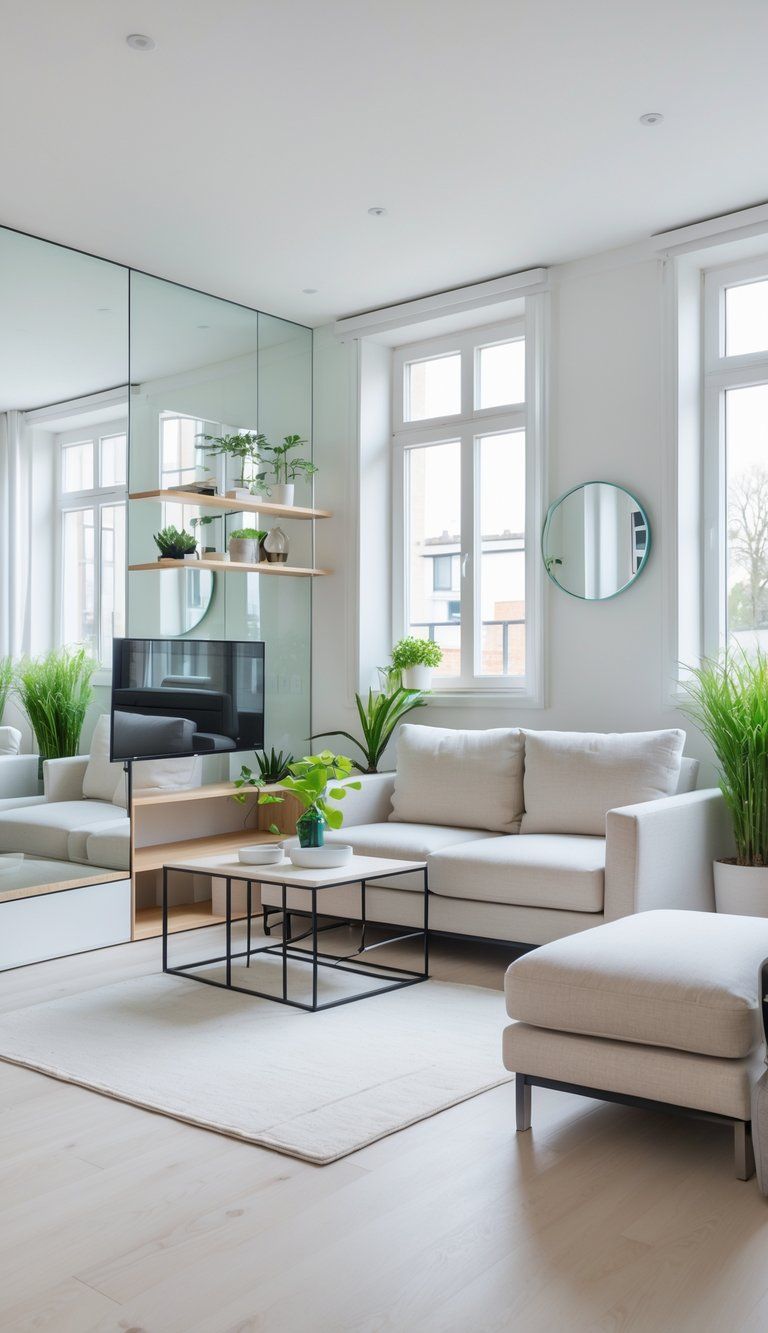
The furniture you pick—and how you arrange it—can make or break a small room. Smart choices keep things open and practical, without crowding you out.
Opting for Furniture with Legs
Furniture with legs keeps things feeling airy. When you can see the floor underneath, the room just feels bigger.
Look for sofas, chairs, and tables that aren’t boxy or sitting flat on the ground. Even a few inches of visible floor makes a big difference.
Mid-century modern pieces are great for this. Their slim legs and clean lines don’t overpower a small room.
If you’re shopping, try to find furniture with tapered legs. They look elegant but still feel light. Even your bed can have legs—suddenly the whole bedroom opens up.
Incorporating Transparent and Clear Furniture
Clear furniture is a lifesaver in tight spaces. It gives you function but doesn’t visually clutter things up.
Acrylic or glass coffee tables, side tables, or even dining chairs just fade into the background while still being useful.
A glass dining table works wonders in a tiny eating area. You get the surface you need, but the room stays open.
Ghost chairs are a personal favorite for small dining nooks or home offices. They’re comfy but don’t take up any visual space.
Pro tip: Glass shelves reflect light and make your walls seem to fall away.
Embracing Multi-Functional Pieces
Every piece needs to pull double duty in a small space. Multi-functional furniture saves your sanity and your square footage.
Go for ottoman benches with storage, extendable dining tables, sofa beds, Murphy beds, or nesting tables.
A daybed can handle both seating and sleeping if you’re in a studio. Add storage drawers underneath for bonus points.
Wall-mounted desks fold away when you’re done with them. Drop-leaf tables expand for dinner, then shrink right back down.
Storage headboards are another underrated trick. They use vertical space and keep your essentials close by.
Decluttering for a Spacious Look
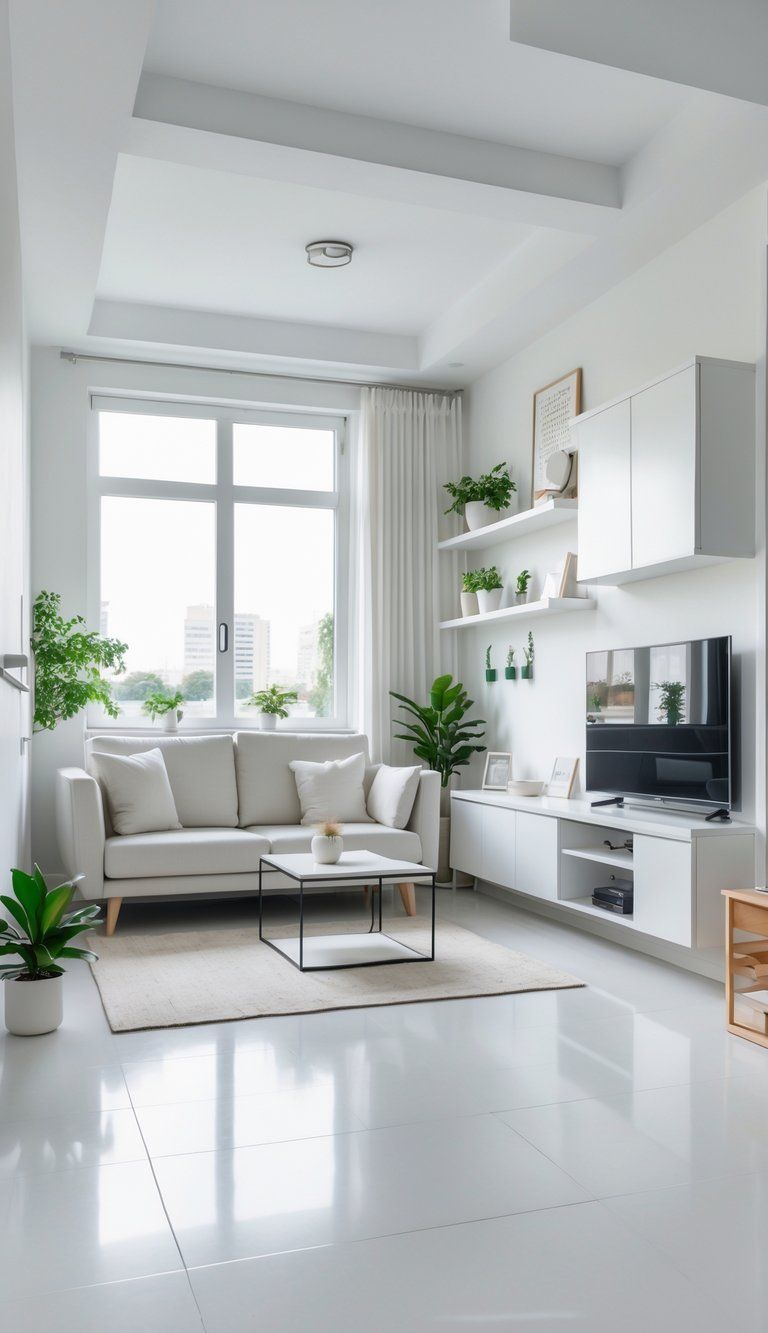
Getting rid of extra stuff is step one for making any small space feel bigger. A tidy space just feels better—it gives your eyes a place to rest.
Minimalism and Simplicity
Try to live by “less is more” in small rooms. Toss or donate anything you haven’t used in a year. If you’re on the fence, box it up for a month. If you forget about it, it’s probably safe to let it go.
Make a rule: for every new thing you bring in, something else has to leave. It keeps clutter from creeping back in.
Go for quality over quantity. One great piece beats a bunch of so-so ones. Like, a nice wooden chest can double as a coffee table and hide blankets inside.
Only keep out what you love or what you actually use. Try to keep about half your surfaces clear so things don’t feel crowded.
Hidden Storage Tips
Look for furniture with built-in storage. Beds with drawers underneath are genius. Storage ottomans hide everything from toys to extra bedding and still give you a spot to sit.
Go vertical with tall, skinny bookcases or floating shelves. Install shelves high up for stuff you don’t need all the time.
Get sneaky with hidden solutions: under-stair storage, hollow benches, or tables with drawers. Even the back of a door can hold an organizer for shoes or cleaning supplies.
Pick containers that look good with your decor. Woven baskets, pretty boxes, or matching bins keep things tidy and easy to find. Label everything so you don’t forget what’s where.
Using Patterns and Textures Effectively
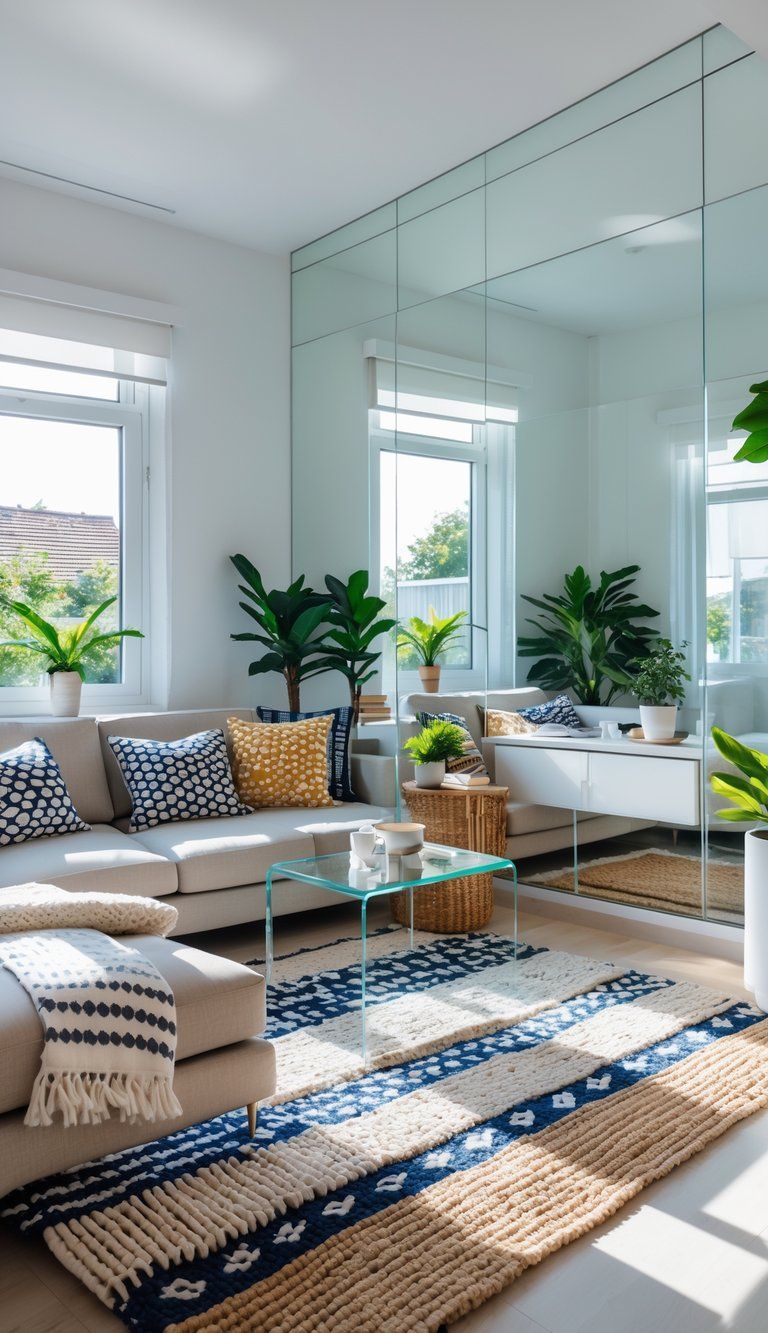
Patterns and textures, when you use them right, can totally transform a small space. They add depth and personality, making your room feel more interesting and, honestly, a lot more inviting.
Leveraging Vertical Stripes and Lines
Vertical stripes really work wonders in small rooms. They pull your gaze upward, making ceilings look higher and the whole space feel bigger.
Try putting striped wallpaper on just one accent wall. That way, you get the effect without feeling overwhelmed by too much pattern.
You can create similar magic with paint. Paint vertical stripes in soft, tone-on-tone colors for a classy vibe that also stretches the room upward.
Window treatments give you another shot at vertical emphasis. Hang floor-to-ceiling curtains with vertical patterns—they’ll make your windows seem taller and the room more dramatic.
If you’d rather keep things subtle, look for vertical elements in your furniture and accessories. Tall bookcases, floor lamps, and vertically arranged wall art all help make a space feel taller.
Plain Upholstery Choices
When you’re shopping for small-space furniture, plain upholstery is usually the way to go. Solid colors make things look cleaner and less crowded, so the room feels more open.
Go for textured solids—think a linen sofa or a velvet chair. Texture keeps things interesting without the chaos of patterns. It’s easier on the eyes and helps everything flow together.
You can still have fun with pattern—just use it sparingly. Throw pillows and little accessories are perfect for adding a pop, and you can swap them out whenever you want.
Stick with neutral upholstery if you want your space to look bigger. Light beiges, soft grays, and warm whites bounce light around and make the room feel fresh and airy.
Accent with Striped Rugs
Striped rugs can totally change how a small space feels. If you lay the stripes lengthwise, the room looks longer. If you run them across, a narrow space will seem wider.
Pick thin, close-together stripes instead of bold, wide ones for small rooms. That way, you get movement without overwhelming everything. Black and white or muted tones usually look sharp.
Lay your striped rug to guide traffic and highlight your room’s best angle. In a narrow hallway, a striped runner can pull you forward and make the space feel longer.
Just don’t let your rug fight with other patterns. If you’ve already got patterns elsewhere, keep your rug subtle so the room stays harmonious.
Optimizing Layout and Flow
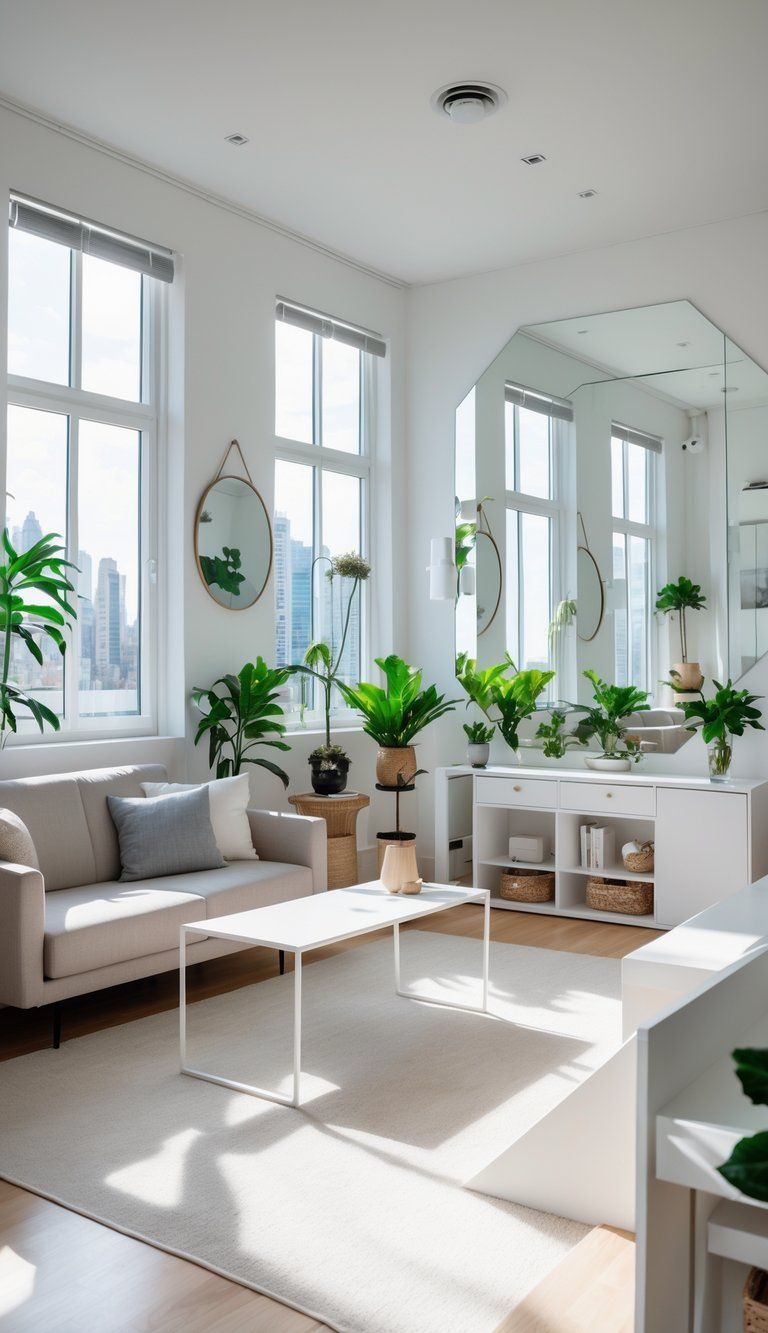
The right layout can make a small space feel a lot bigger and more useful. If you arrange furniture smartly and keep clear pathways, even a tiny room can feel open and welcoming.
Flexible Room Arrangement
Pick furniture that you can move easily. Lightweight pieces with legs look lighter and airier than big, blocky ones. A small round table usually works better than a rectangle because it’s easier to walk around.
Consider these options:
- Nesting tables you can split up when guests come over
- Foldable dining chairs you can stash away when you don’t need them
- Ottomans with wheels that double as seating or tables
Leave space between your furniture—even a few inches between the sofa and the wall helps a room breathe. Don’t shove everything against the walls; it actually makes the room feel boxy.
Creating Visual Pathways
Plan your room so people can walk through easily. Try to keep at least 30 inches of walking space between pieces. It’s just more comfortable that way.
Use area rugs to set up zones in open spaces. A living area rug draws a visual boundary without putting up walls.
Lighting makes a huge difference in how a room flows. Here are a few tricks:
- Put floor lamps in corners to draw the eye up
- Use wall sconces instead of table lamps to free up surfaces
- Hang mirrors across from windows to bounce light around
Arrange your furniture so it naturally leads your eye through the room. For example, face your sofa toward the main feature—maybe a window or your media setup.
Vertical and Hidden Storage Opportunities
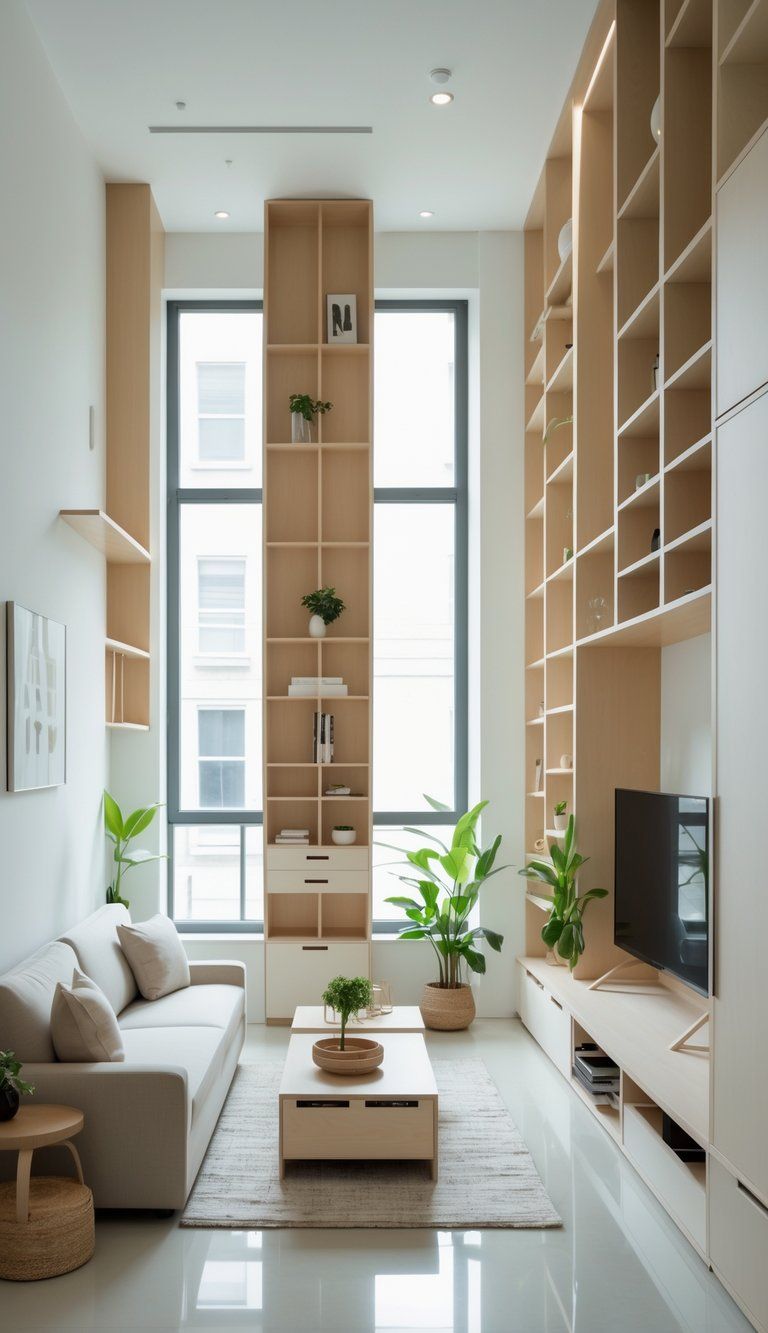
If you’re tight on space, storage makes all the difference. Get creative and use spots you might normally ignore to keep clutter at bay.
Utilizing Vertical Storage
Wall-mounted shelves turn empty walls into storage. Try floating shelves up near the ceiling to pull the eye upward and keep stuff off the floor.
Wall pegboards bring flexible storage that you can change as you need. They’re great for kitchens, offices, or craft rooms—hang tools, supplies, or just fun decor.
Tall, skinny bookcases let you store plenty without hogging floor space. Built-in shelves that go all the way up look sleek and maximize every inch.
Don’t forget under the stairs. Custom drawers or cabinets here can stash seasonal stuff, books, or whatever you need out of sight.
Clever Shelf Placement
Corner shelves make use of those awkward spots most people ignore. Floating corner shelves add storage without bulky furniture taking over.
Over-door shelves or hooks are a breeze to add. They work well in bathrooms, bedrooms, or entryways for things you grab often.
Shelving next to windows can frame the window and give you extra display space. Thin shelves around windows draw attention to the light and look pretty cool.
Built-in nooks between wall studs offer recessed storage that doesn’t stick out. Bathrooms and hallways are perfect for these—you get storage without taking up any space.
Multi-purpose furniture with hidden storage is a lifesaver. Hunt for coffee tables with lift-up tops, ottomans with storage inside, or beds with drawers underneath.
Decor and Accessories for Illusion of Space
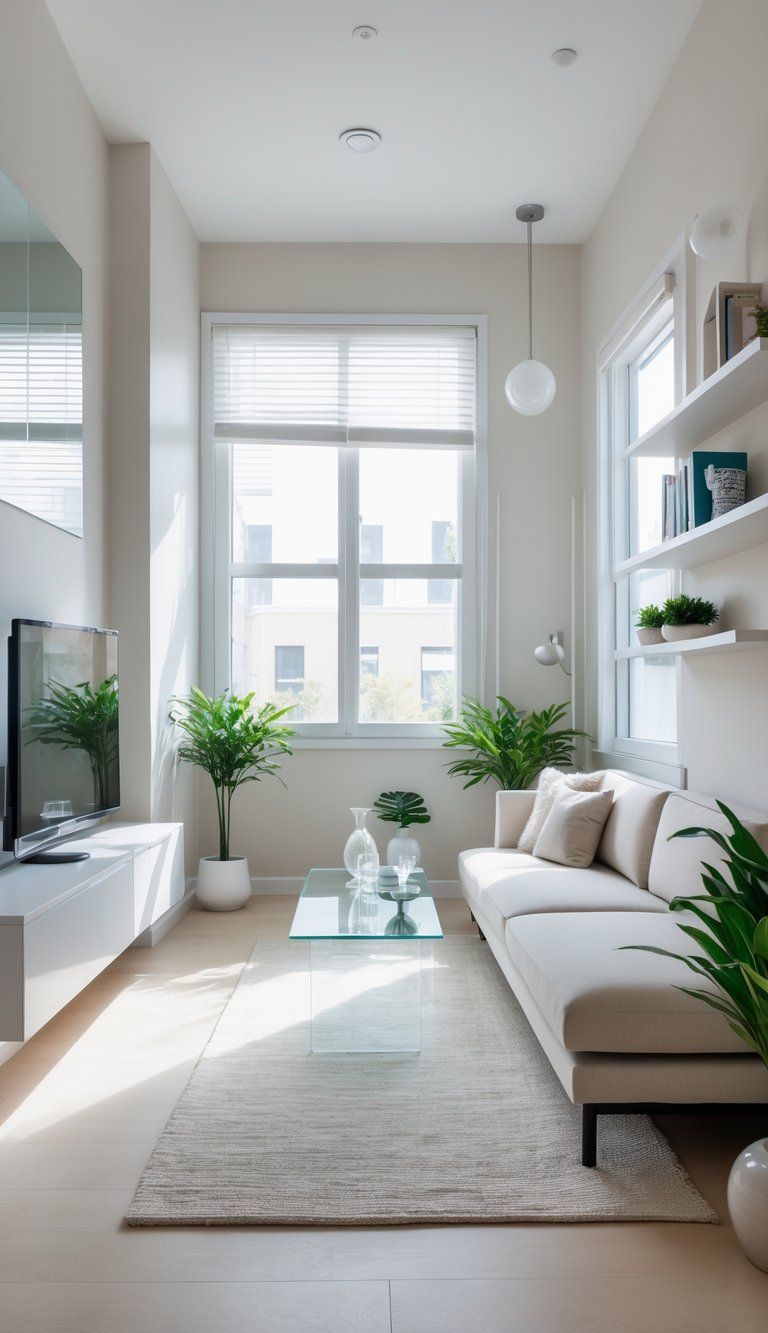
The right decor can turn a cramped room into one that feels open and relaxed. If you accessorize thoughtfully, you’ll get visual breathing room without losing your style.
Curating Accessories Thoughtfully
In small spaces, less really is more. Pick a few statement pieces instead of lots of little things that just clutter everything up. Choose accessories with glass, crystal, or metallic finishes—they bounce light and keep things bright.
Storage baskets and decorative boxes hide clutter and look good doing it. On a small nightstand, keep it simple. Maybe just a lamp, a tiny plant, and a book.
Pay attention to scale. Big accessories can swamp a small room, but tiny ones get lost. Medium-sized pieces usually hit the sweet spot.
Pro tip: Group accessories in odd numbers—like three or five—and vary their heights. It keeps things interesting without feeling messy.
Art and Wall Decor Placement
Hang art to draw the eye up and make the room feel taller. One large piece usually works better than a bunch of small frames, which can look busy. Try hanging your art a little higher than usual to stretch the space visually.
Mirrors are a lifesaver in tiny rooms. Put a big mirror across from a window to double the natural light and add depth. Here are some mirror ideas:
- Hang one behind furniture to make it look like the room goes further
- Put mirrors on closet doors in a small bedroom to visually double the space
- Use a few decorative mirrors instead of a classic gallery wall
Wall-mounted shelves give you a spot for display without eating up floor space. Keep them simple—just a few favorite objects.
Go for vertical art arrangements to emphasize height. Horizontal groupings can make the room feel squat.
Room-Specific Small Space Solutions

Every room has its own small space headaches, right? With the right tricks, though, you can make each area feel bigger and more functional.
Design Tricks for Small Living Rooms
Furniture placement in small living rooms is everything. Pick a sofa that fits the room—giant sectionals just swallow up space. Armless sofas or chairs look lighter and don’t crowd the room visually.
Multi-functional furniture will save you. Try coffee tables with storage or nesting tables you can tuck away. Wall shelves keep stuff off the floor and double as display.
Set up conversation areas by pulling furniture away from the walls. It sounds weird, but it actually creates depth.
Mix up your lighting sources. Don’t rely on a single overhead fixture. Table lamps, floor lamps, and wall sconces spread light around and make the room feel bigger.
Maximizing a Small Bedroom
The bed takes up most of the bedroom, so make it work for you. Platform beds with built-in storage underneath are super practical. Beds with visible legs show off more floor and make things feel airier.
Scale down your nightstands—try floating shelves or wall-mounted ones instead of chunky tables. You’ll keep walkways clear and still have a spot for essentials.
Go for wardrobes or closets that reach the ceiling. They draw the eye up and give you more storage. Ditch closet doors for curtains if you want to save space—they don’t need extra room to open.
Mount reading lights on the wall instead of using table lamps. Mirrors that catch natural light will brighten things up and add depth.
Stick to light bedding colors and skip busy patterns. A monochrome look with some texture feels calm and makes the room seem larger.
Functional Small Kitchens
Small kitchens need a plan. Open shelving instead of upper cabinets keeps the space open and makes grabbing things easy. Glass-front cabinets work too if you want to keep some doors.
Try these space-saving ideas:
- Slim appliances made for small spaces
- Magnetic knife strips instead of bulky blocks
- Pot racks to clear up cabinet space
- Pull-out cutting boards that add work space
Use light colors in the kitchen to reflect more light. High-gloss cabinet finishes bounce light around and help the room feel bigger.
Go vertical with tall pantry cabinets—they hold a lot without taking up much floor. Under-cabinet lighting is a nice touch for tasks and makes counters look deeper.
Smart Entryway Ideas
Even a tiny entryway can feel both functional and inviting. I love using wall-mounted hooks—they save space and give you a spot for coats and bags.
Try a narrow console table if you need somewhere to toss your keys. It won’t block the walkway, which is always a plus.
Mirrors work wonders in an entryway. They make the space look bigger and let you check your hair before heading out.
Pick a big, bold mirror if you want to make a statement. It really changes the vibe.
You might want to add a built-in bench with storage underneath for shoes. These benches fit into corners or little nooks you’d otherwise ignore.
Lighting makes a huge difference here since entryways usually don’t get much natural light. Sconces won’t take up any floor or table space, but they’ll make the place feel warm and welcoming.
If you’ve got the ceiling height, hang a pendant light. It draws your eye up and somehow makes the entryway feel taller.
Don’t forget about the floor. Using the same flooring from your entryway into the next room helps everything flow together. It’s a small detail, but it matters.

